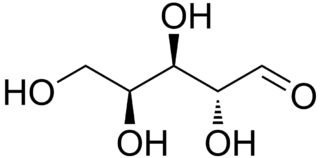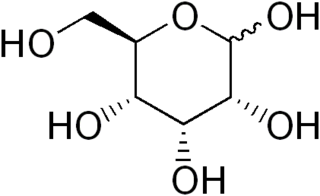
In chemistry, solubility is the ability of a substance, the solute, to form a solution with another substance, the solvent. Insolubility is the opposite property, the inability of the solute to form such a solution.

In chemistry, a hexose is a monosaccharide (simple sugar) with six carbon atoms. The chemical formula for all hexoses is C6H12O6, and their molecular weight is 180.156 g/mol.
In stereochemistry, an epimer is one of a pair of diastereomers. The two epimers have opposite configuration at only one stereogenic center out of at least two. All other stereogenic centers in the molecules are the same in each. Epimerization is the interconversion of one epimer to the other epimer.

Glucuronic acid is a uronic acid that was first isolated from urine. It is found in many gums such as gum arabic, xanthan, and kombucha tea and is important for the metabolism of microorganisms, plants and animals.

Lyxose is an aldopentose — a monosaccharide containing five carbon atoms, and including an aldehyde functional group. It has chemical formula C5H10O5. It is a C'-2 carbon epimer of the sugar xylose. The name "lyxose" comes from reversing the prefix "xyl" in "xylose".

Allose is an aldohexose sugar. It is a rare monosaccharide that occurs as a 6-O-cinnamyl glycoside in the leaves of the African shrub Protea rubropilosa. Extracts from the fresh-water alga Ochromas malhamensis contain this sugar but of unknown absolute configuration. It is soluble in water and practically insoluble in methanol.

Gulose is an aldohexose sugar. It is a monosaccharide that is very rare in nature, but has been found in archaea, bacteria and eukaryotes. It also exists as a syrup with a sweet taste. It is soluble in water and slightly soluble in methanol. Neither the d- nor l-forms are fermentable by yeast.

Altrose is an aldohexose sugar. D-Altrose is an unnatural monosaccharide. It is soluble in water and practically insoluble in methanol. However, L-altrose has been isolated from strains of the bacterium Butyrivibrio fibrisolvens.
The Kiliani–Fischer synthesis, named for German chemists Heinrich Kiliani and Emil Fischer, is a method for synthesizing monosaccharides. It proceeds via synthesis and hydrolysis of a cyanohydrin, followed by reduction of the intermediate acid to the aldehyde, thus elongating the carbon chain of an aldose by one carbon atom while preserving stereochemistry on all the previously present chiral carbons. The new chiral carbon is produced with both stereochemistries, so the product of a Kiliani–Fischer synthesis is a mixture of two diastereomeric sugars, called epimers. For example, D-arabinose is converted to a mixture of D-glucose and D-mannose.
In enzymology, a GDP-mannose 3,5-epimerase is an enzyme that catalyzes the chemical reaction

Viqualine (INN) is an antidepressant and anxiolytic drug that was never marketed. It acts as a potent and selective serotonin releasing agent and serotonin reuptake inhibitor. In addition, viqualine displaces diazepam from the GABAA receptor and produces benzodiazepine-like effects, indicating that it is also a positive allosteric modulator of the benzodiazepine site of the GABAA receptor. The drug has mainly been researched as a potential treatment for alcoholism.

δ-Cadinol is an organic compound, a sesquiterpenoid alcohol produced by many plants as well as some animals and microorganisms. It is a white crystalline solid, soluble in isopropyl ether and ethanol. It is an epimer of α-cadinol.
DTDP-6-deoxy-L-talose 4-dehydrogenase (NAD+) (EC 1.1.1.339, tll (gene name)) is an enzyme with systematic name dTDP-6-deoxy-beta-L-talose:NAD+ 4-oxidoreductase. This enzyme catalyses the following chemical reaction
DTDP-L-rhamnose 4-epimerase is an enzyme with systematic name dTDP-6-deoxy-beta-L-talose 4-epimerase. This enzyme catalyses the following chemical reaction

Fumigaclavine A is an antibacterial ergoline alkaloid produced by endophytic Aspergillus.

Fumigaclavine C is an ergoline alkaloid produced by Aspergillus fumigatus.

Fumigaclavine B is an ergoline compound made by certain fungi.

Epiestriol (INN), or epioestriol (BAN), also known as 16β-epiestriol or simply 16-epiestriol as well as 16β-hydroxy-17β-estradiol, is a minor and weak endogenous estrogen, and the 16β-epimer of estriol. Epiestriol is used clinically in the treatment of acne. In addition to its estrogenic actions, epiestriol has been found to possess significant anti-inflammatory properties without glycogenic activity or immunosuppressive effects, an interesting finding that is in contrast to conventional anti-inflammatory steroids like hydrocortisone.

Dexbudesonide is a synthetic glucocorticoid corticosteroid which was never marketed. It is the 22R-epimer of budesonide.

17β-Methyl-17α-dihydroequilenin, also known as 17β-methyl-6,8-didehydro-17α-estradiol, is a synthetic steroidal estrogen which was never marketed. It is the C17β methylated derivative of 17α-dihydroequilenin, an equine estrogen and constituent of conjugated estrogens (Premarin). 17α-Dihydroequilenin itself is an analogue of 17α-estradiol, the C17 epimer of estradiol. NCI-122 has respective relative binding affinities of about 8.1% and 16% for the ERα and ERβ when compared to estradiol. It is far less potent as an estrogen in comparison to estradiol, with relative estrogenic potencies at the ERα and ERβ of 1.4% and 0.81%, respectively. Nonetheless, NCI-122 acts as a full agonist of the ERα and has estrogenic activity similar to that of estradiol at sufficiently high concentrations. The mechanisms of the lower potency of NCI-122 and related estrogens relative to estradiol have been studied.
















